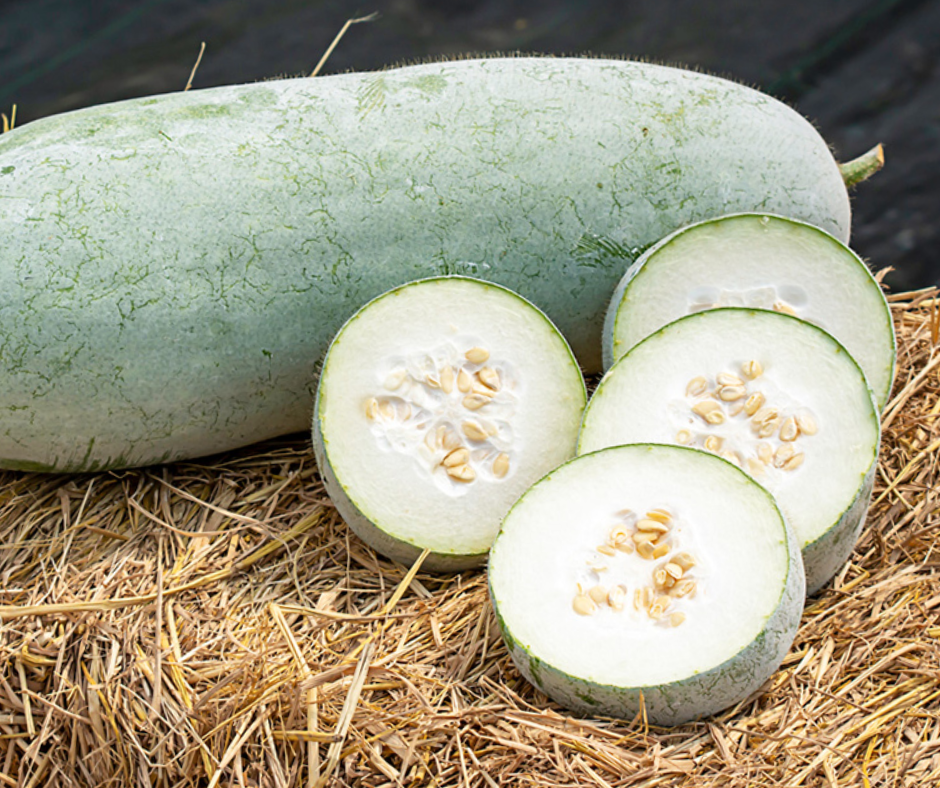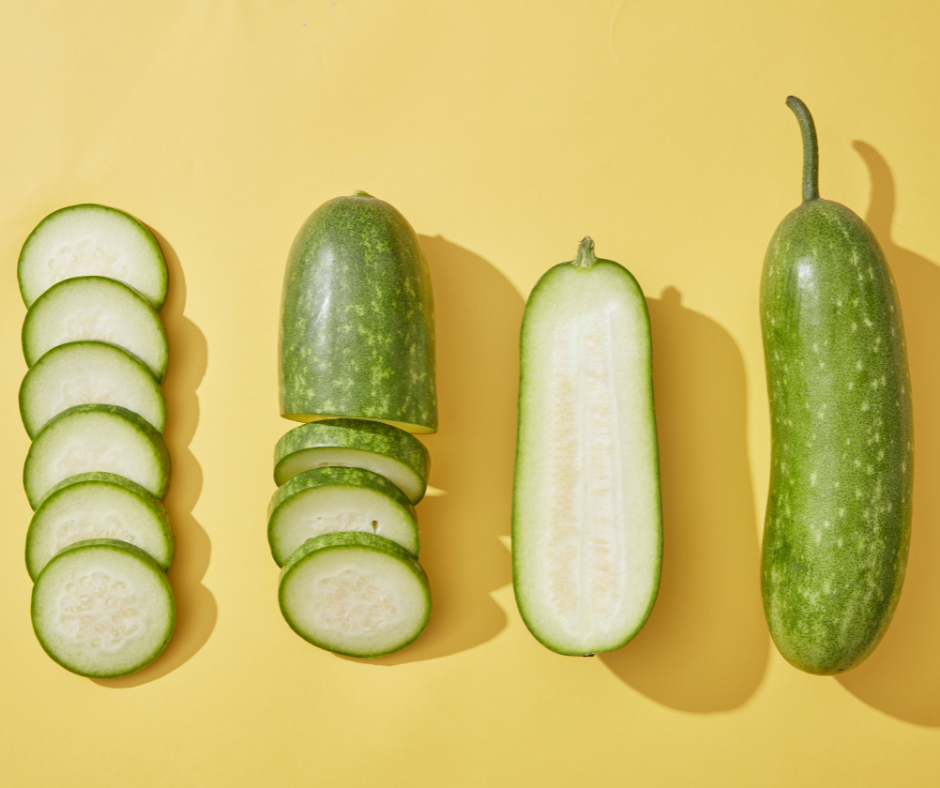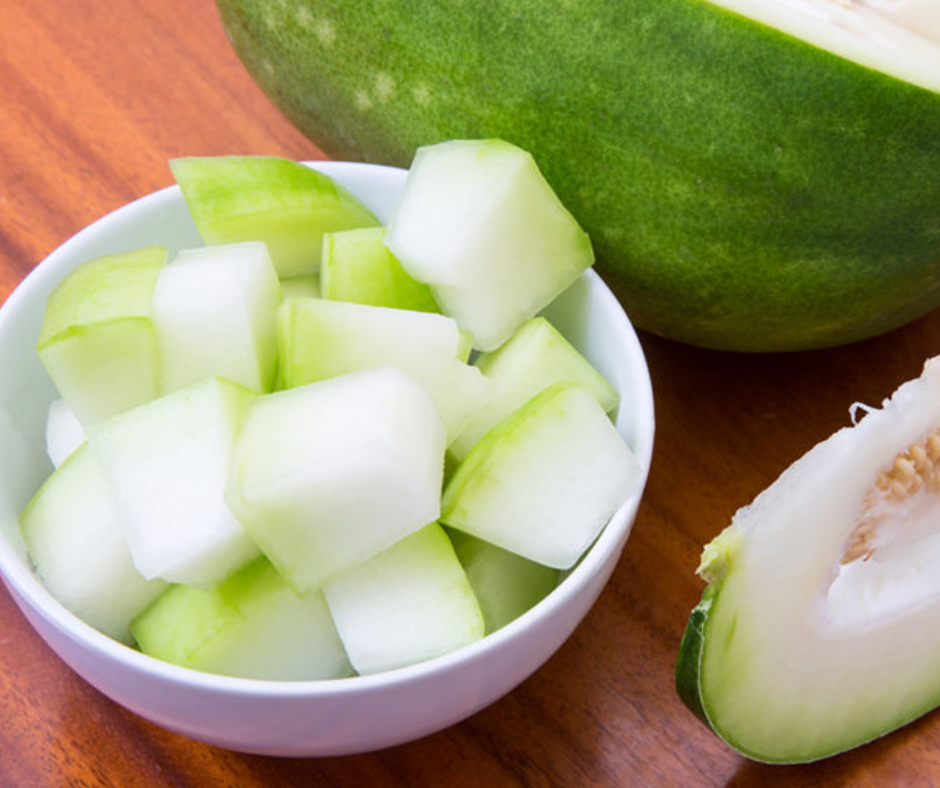Introduction
Winter melon is a large fruit that is widely used in Asian cuisine. It is a popular ingredient for soups, stews, stir-fries, and desserts. The fruit has a hard exterior that can be cut open to reveal a white flesh similar to a cucumber in texture. But What Does Winter Melon Taste Like?
What Is Winter Melon?
Winter melon is a fruit that belongs to the gourd family. It originated in Southeast Asia and is now grown in many parts of the world. The fruit can grow up to a meter in length and is weighed in kilograms. When the fruit matures, it has a mild flavor similar to cucumber with a slightly grassy note. The immature fruit is smaller in size and has a more concentrated sweetness.
Why Is Understanding Winter Melon Flavor Important?
Understanding the flavor of winter melon is important because it can help you determine how to use it in your cooking. The fruit can be bland initially or have a slightly sweet taste if it is immature. However, when cooked with other ingredients, it can take on bold, dynamic flavors.
The flavor of the winter melon is similar to the white rind of the watermelon. This gentle flavor makes it a great ingredient for savory dishes and dessert recipes. When cooking with winter melon, it is important to understand its flavor and texture before incorporating it into your recipe. With proper preparation and cooking, the winter melon can be a delicious ingredient in many dishes.
Winter Melon Taste 101
Winter melon is a large gourd that is commonly used in Asian cuisine. Its flesh is similar to cucumber in texture and can be bland at first taste. However, its flavor can be transformed when cooked with other ingredients. This section will discuss ‘What Does Winter Melon Taste Like?’ and compare it to other melons and fruits.
What Does Winter Melon Taste Like?
A mature winter melon has a mild flavor comparable to cucumber with a slightly grassy note. Despite its bland taste, it can absorb the flavors of other ingredients and take on bold, dynamic flavors when cooked. This makes it an ideal ingredient for savory dishes. On the other hand, a young winter melon has a sweet taste that is similar to honeydew or cantaloupe. However, it is rarely eaten raw, as it is best when cooked.
It is important to note that winter melon seeds are also edible and have a nutty flavor when cooked. The flesh of the winter melon is firm yet watery and juicy and becomes transparent and soft when cooked. Its tender texture and unique flavor make it a great ingredient for soups, stews, stir-fries, and desserts.
Comparing Winter Melon To Other Melons And Fruits
Winter melons have a flavor similar to the white rind of watermelon. However, watermelon has a sweeter and more vibrant taste. Compared to cantaloupe and honeydew melons, winter melon has a milder taste and a firmer texture. These other melons have a juicier and more flavorful experience that can overpower the palate.
When it comes to cooking, winter melon is a versatile ingredient that can take on a variety of flavors and textures. It can add a tender, mild flavor to savory dishes and provide a subtle sweetness to desserts. Its unique properties make it an exciting ingredient to experiment with in the kitchen.
In conclusion, winter melon is a versatile and unique ingredient that adds a tender and mild flavor to dishes. Understanding its flavor profile is important when incorporating it into your meals. With proper preparation and cooking techniques, winter melon can be a delicious addition to various dishes.
The Blandness Of Winter Melon
Winter melon, also known as ash gourd, wax gourd, white pumpkin, or Chinese watermelon, is commonly used in Asian cuisine. It has a mild and subtle flavor that can seem bland at first bite.
Why Winter Melon Can Seem Bland At First Bite
A mature winter melon has a mild flavor comparable to cucumber with a slightly grassy note. Its pale flesh is firm yet watery and juicy, becoming transparent and soft when cooked. Despite its bland taste, it can absorb the flavors of other ingredients and take on bold, dynamic flavors when cooked. However, a young winter melon tastes sweet, like honeydew or cantaloupe.
How To Enhance The Flavor Of Winter Melon
While winter melon may seem bland, it can be transformed when cooked with other ingredients. Its unique texture and flavor make it a versatile ingredient in various dishes. Winter melon is an ideal ingredient for savory dishes such as soups, stews, and stir-fries, as it absorbs other flavors well. When used in desserts, it provides a subtle sweetness and a tender texture.
To enhance the flavor of winter melon, it can be cooked with spices, sauces, and herbs. For example, cooking winter melon with garlic, ginger, and soy sauce can give it a savory and flavorful taste. Adding it to a curry can also bring out its mild flavor while adding complexity to the dish.
In conclusion, winter melon may seem bland initially, but it can be a flavorful and exciting ingredient if prepared and cooked properly. Its unique texture and flavor make it an ideal ingredient for various dishes, and it can be transformed when cooked with other ingredients. By experimenting with different spices, sauces, and cooking techniques, one can unlock the full potential of this versatile gourd.
Taking On Bold Flavors
Winter melon may have a bland taste, but it can absorb the flavors of other ingredients and take on bold and dynamic flavors when cooked. This makes it a versatile ingredient in the kitchen, especially in savory dishes. Its unique texture and flavor make it an ideal ingredient for stews, soups, and stir-fries.
Winter Melon’s Versatility In Savory Dishes
Winter melon’s mild flavor allows it to be paired with various spices and sauces. Cooking it with garlic, ginger, and soy sauce gives it a savory and flavorful taste. Adding it to curries brings out its subtle and mild flavor while at the same time adding complexity of flavors to the dish. In Filipino cuisine, it is often used as an ingredient in the popular dish “Nilaga,” a soup made with meat and vegetables. In Chinese cuisine, winter melon is used in various dishes, including stir-fried winter melon with pork and seafood.
Winter Melon Recipes Featuring Bold Flavors
One way to feature winter melon’s ability to take on bold flavors is by making a winter melon curry. A mix of winter melon, coconut milk, curry powder, and other spices can create a hearty and fragrant dish that will take your taste buds on a journey. Another recipe that features winter melon’s flavor-absorbing qualities is a winter melon and pork stew. Along with other ingredients like green onions and garlic, the winter melon will soak up the rich and savory broth of the stew, delivering an explosion of flavors in each bite.
In conclusion, winter melon may start as bland but can take on bold and dynamic flavors when cooked with other ingredients. Its versatility in savory dishes makes it a fantastic ingredient to add to your repertoire. You can transform winter melon into a delicious and flavorful dish with a few spices and creativity.
Sweetness In Youth
How Young Winter Melon Differs From Mature Winter Melon
Winter melon, or ash or white gourd, is a large fruit commonly found in Asian cuisine. When shopping for winter melon, one can choose from a mature or an immature version of the fruit. Young winter melon is smaller and has a more concentrated sweetness than the mature fruit’s mild taste. The winter melon’s overall flavor resembles the watermelon’s white rind.
Comparing The Sweetness Of Young Winter Melon To Other Melons
Young winter melon’s sweet flavor can be likened to cantaloupe or honeydew melons. Its sweetness is more pronounced than mature winter melon, making it a great addition to desserts and sweet beverages. Its mild taste makes it an ideal ingredient for savory dishes, allowing it to take on bold and dynamic flavors when cooked with other ingredients.
Overall, young winter melon may have a concentrated sweetness, but its versatility in sweet and savory dishes makes it an ingredient worth exploring in the kitchen. Whether cooked alone or paired with other bold flavors, winter melon can elevate any dish with its unique texture and mild taste.
Inside The Winter Melon Flesh
Texture And Consistency Of Winter Melon Flesh
Winter melon is a versatile ingredient in Asian cuisine, beloved for its mild flavor and unique texture. When cooked, the winter melon has a firm yet somewhat watery flesh. This texture results from its high water content, making it a refreshing ingredient in soups and stews. The consistency of winter melon also makes it a popular ingredient in traditional Chinese medicine, which is believed to help cool the body and reduce inflammation.
The Edible Seeds Of Winter Melon
In addition to its flesh, the winter melon contains edible seeds that are nutty when cooked. Contrary to popular belief, the seeds need not be removed before cooking the winter melon. Instead, they can be left in and cooked alongside the flesh, adding flavor and texture to dishes. Some recipes even call for the seeds to be removed and roasted, adding a crunchy element to salads and other dishes.
Winter melon is a versatile ingredient that deserves a place in any kitchen. Its mild flavor and unique texture make it an ideal ingredient for soups, stews, and other savory dishes. Its sweetness also makes it a great addition to desserts and sweet beverages. Next time you come across a winter melon in your local market, consider trying it and exploring the endless possibilities it offers in the kitchen.
The Nuttiness Of Winter Melon Seeds
Flavor Profile And Uses Of Winter Melon Seeds In Cooking
Winter melons are not only known for their flesh but also for their edible and nutritious seeds. Contrary to popular belief, the seeds must not be removed before cooking the winter melon. Instead, they can be left in and cooked with the flesh, adding a nutty flavor to dishes.
When cooked, the seeds have a neutral taste that will complement and enhance the flavor of any dish. This makes them versatile in savory dishes like soups, stews, and stir-fries. They pair especially well with other vegetables and meats. They can also be roasted and added to salads for a delicious crunch.
Winter Melon Seed Recipes
Winter melon seeds can be incorporated into various dishes for flavor and nutrition. Here are a few recipes to try:
- Winter Melon Soup with Seeds – This flavorful soup combines winter melon flesh and seeds with chicken broth, ginger, and garlic for a warming, healthy meal.
- Winter Melon Stir Fry with Seeds – This quick and easy dish features winter melon slices and seeds stir-fried with onions, bell peppers, and sesame oil. Serve with rice for a satisfying meal.
- Roasted Winter Melon Seeds – These crunchy seeds can be roasted with salt and spices to create a tasty snack or salad topping.
In conclusion, winter melon seeds are a flavorful and versatile ingredient that adds nutrition and nuttiness to any dish. They are easy to prepare and can be incorporated into various recipes. If you have never tried winter melon seeds before, try them in your next dish and experience their delicious flavor.
Cooking With Winter Melon
How Cooking Affects Winter Melon Flavor And Texture
When it comes to cooking with winter melon, the texture and flavor of this mild-tasting vegetable can change depending on how it’s prepared. The winter melon softens and tastes slightly sweet if you sauté it with a little oil. However, roasting the winter melon is a great option if you prefer a bit of crunch. Roasting brings out the nuttiness of the seeds and creates a unique taste experience.
Favorite Winter Melon Dishes From Around The World
Winter melon is a popular ingredient in many cuisines around the world. Here are a few favorite dishes:
- Chinese Winter Melon Soup: This comforting soup simmers winter melon with chicken broth, ginger, and garlic. It’s a staple in many Chinese households during the winter months.
- Filipino Ginataang Upo: This dish combines winter melon with coconut milk, shrimp, and spices for a creamy and flavorful meal.
- Indian Lauki Ki Sabzi: In this dish, winter melon is cooked with turmeric, cumin, and coriander to create a fragrant and delicious vegetable side.
- Thai Yum Woonsen: This refreshing salad features winter melon, glass noodles, and a spicy lime dressing. It’s a great way to enjoy winter melon in a lighter dish.
Whether roasting, boiling, or stir-frying, winter melon is a versatile and nutritious ingredient that can be enjoyed in many dishes. Experiment with different cooking methods and cuisines to discover your favorite winter melon recipes.
Cooking With Winter Melon
How Cooking Affects Winter Melon Flavor And Texture
Winter melon is a mild-tasting vegetable that can change in texture and flavor depending on how it’s prepared. Sautéing it in a little oil softens the winter melon and adds a slightly sweet taste. On the other hand, roasting brings out the nuttiness of the seeds and creates a unique taste experience that’s perfect for those who prefer a bit of crunch.
Favorite Winter Melon Dishes From Around The World
Winter melon is a popular ingredient in many cuisines worldwide. Chinese households make a comforting soup during winter months: Chinese Winter Melon Soup. This recipe simmers winter melon with chicken broth, ginger, and garlic.
Another delicious dish that winter melon pairs well with is Filipino Ginataang Upo. This dish combines winter melon with shrimp, coconut milk, and spices. Indian Lauki Ki Sabzi uses winter melon and cooks it with turmeric, cumin, and coriander to create a fragrant and delicious vegetable side. Thai Yum Woonsen features winter melon with glass noodles and a spicy lime dressing for a refreshing salad that’s tasty and healthy.
Conclusion
Appreciating The Subtle Flavor Of Winter Melon
Now you should know the answer to ‘What Does Winter Melon Taste Like?’. While some may find winter melon bland, its mild flavor makes it a versatile ingredient in many recipes worldwide. Its ability to take on different flavors and cooking techniques makes it a valuable addition to many cuisines.
Winter Melon Is A Versatile And Delicious Ingredient
Winter melon can be cooked in various ways, including sautéing, roasting, and stir-frying. It pairs well with many spices and other ingredients, making it versatile in many dishes. It is also nutritious, as it is low in calories and high in fiber and essential vitamins. Winter melon is a versatile and delicious ingredient worth incorporating into your cooking repertoire.
The taste of winter melon can be likened to the white rind of a watermelon. It has a gentle flavor similar to a cucumber but with a slight grassy note. At first bite, it might seem bland, but as it cooks, it can take on bold and dynamic flavors. This makes it an ideal ingredient for savory dishes. On the other hand, a young winter melon has a sugary taste that’s comparable to a honeydew or cantaloupe. Overall, the flavor of winter melon is subtle and delicate, making it a versatile ingredient in various culinary applications.



